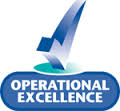Operational Excellence in the Intelligent Enterprise
 What does intelligence in the enterprise imply? If we think of this from an operations perspective the most important characteristics of the intelligent enterprise are being precise, accurate and responsive. Precise describes the enterprise’s ability to act very deliberately to attain its goals. Accurate suggests the enterprise’s ability to hit its operational targets while responsive translates into being nimble and highly reactive to opportunities and problem solving. All these positive characteristics can be thought of as the enterprise’s operational effectiveness that requires good planning and execution to reach the highest levels.
What does intelligence in the enterprise imply? If we think of this from an operations perspective the most important characteristics of the intelligent enterprise are being precise, accurate and responsive. Precise describes the enterprise’s ability to act very deliberately to attain its goals. Accurate suggests the enterprise’s ability to hit its operational targets while responsive translates into being nimble and highly reactive to opportunities and problem solving. All these positive characteristics can be thought of as the enterprise’s operational effectiveness that requires good planning and execution to reach the highest levels.
Improving operational effectiveness requires an information infrastructure that supports precise, accurate and responsive actions. On top of that infrastructure sets processes that drive the planning and execution systems from the back office to customer facing systems. Perhaps one of the most critical upstream variables that can help optimize more downstream results is demand forecast accuracy.
Unfortunately demand planning and forecasting are areas of the enterprise that are many times overlooked relative to their importance. The fact is that most enterprises with very clearly defined targets can over time bring their operational execution performance to its highest (most efficient) level. The problem is providing the clear, accurate and timely practical targets for the operational side of the enterprise.
At the very core of this targeting challenge lies the Sales and Operations Planning (S&OP) process that strives to create a consensus-built demand plan with contributors from each part of the business. Operations provides the technical forecasting expertise with an eye towards historical performance along with the rough perspective of the supply plan. Sales and Marketing provides the outside view of both current and future conditions across markets and customers. Management and Finance adds the important business plan view from a top-down perspective that can alter goals and, ultimately, operational plans.
If the intelligent enterprise needs to be precise, accurate and responsive to drive its operational effectiveness to the highest levels and one of the most important variables is demand forecast accuracy, then what does it take to improve the demand planning process and thus the forecast accuracy? The answer lies in:
- Harnessing the right DATA
- What type of data is required, how much is needed and when to use each type of data are key questions. In the real world filled with anomalies and complexities the challenge is how to find the “signal in all the noise” and resolve the data granularity challenge without smothering the overall process.
- Deploying the right information TOOLS
- Balancing art with science using a persistent robust platform that is the “system of record” for supporting and automating the technical forecasting element of the process can be challenging. Adding a collaborative tool to the mix serves to greatly increase the effectiveness of the demand planning process.
- Creating the right PROCESSES
- Important control items include the right measurement systems and structured process flow to drive continuous improvement. Balancing the planning requirements against the collaborator’s own business processes can be very difficult and a source of many project failures.
Business system designers striving to add intelligence to the enterprise are faced with a range of challenges and decisions; but at the very core is the right data, the right tools and the right processes. In future articles we will drill deeper into the details of creating a good demand planning process using the right tools, data and processes.